AUDI RS7 SPORTBACK 2016 Owners Manual
Manufacturer: AUDI, Model Year: 2016, Model line: RS7 SPORTBACK, Model: AUDI RS7 SPORTBACK 2016Pages: 282, PDF Size: 70.78 MB
Page 231 of 282
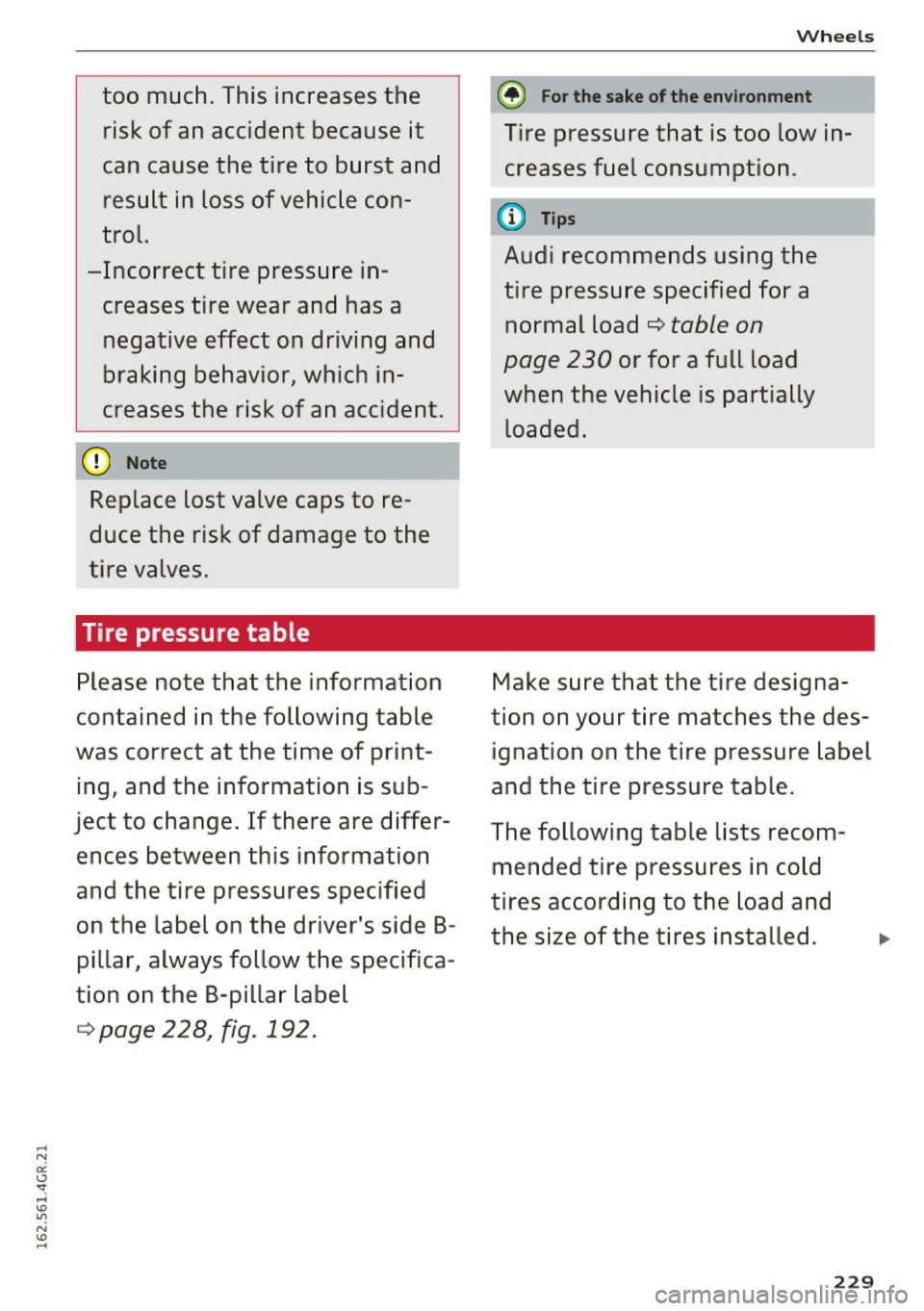
too much. This increases the risk of an accident because it
can cause the tire to burst and result in loss of vehicle con
trol.
-Incorrect tire pressure in
creases tire wear and has a
negative effect on driving and
braking behavior, which in
creases the risk of an accident .
(D Note
Replace lost valve caps to re
duce the risk of damage to the
tire valves.
Tire pressure table
Please note that the information
contained in the following table
was correct at the time of print ing, and the information is sub
ject to change. If there are differ
ences between this information
and the tire pressures specified
on the label on the driver's side B pillar, always follow the specifica
tion on the B-pillar label
¢ page 228, fig. 192.
Wheels
'® For the sake of the environment
Tire pressure that is too low in
creases fuel consumption .
Audi recommends using the
tire pressure specified for a normal load
¢ table on
page 230
or for a full load
when the vehicle is partially
loaded.
Make sure that the tire designa
tion on your tire matches the des ignation on the tire pressure label
and the tire pressure table.
The following table lists recom
mended tire pressures in cold
tires according to the load and
the size of the tires installed . .,.
229
Page 232 of 282
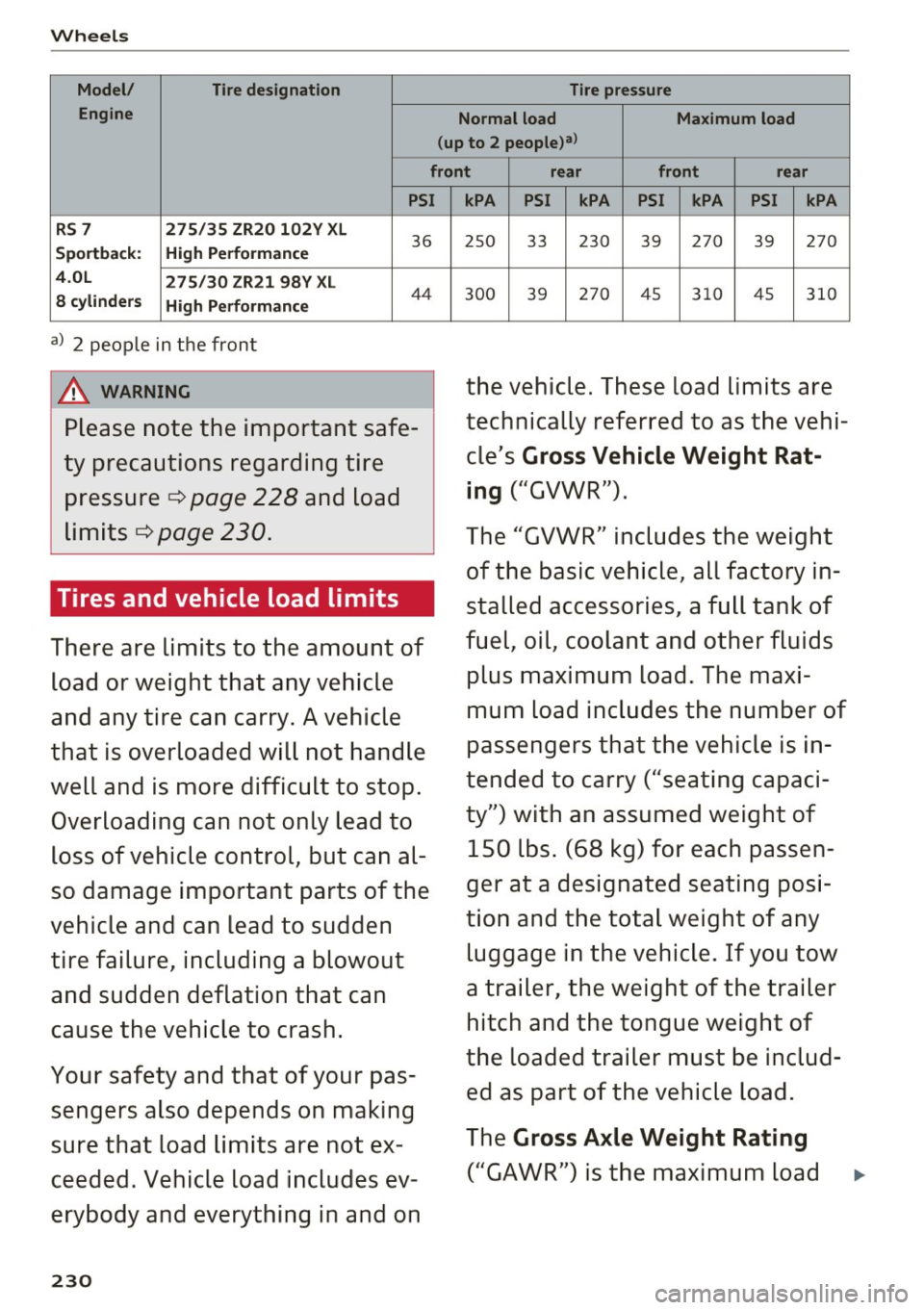
Wheels
Model/ Tire designation Tire pressure
Engine Normal load Maximum load
(up to 2 people)a>
front rear front rear
PSI
RS 7 275/35 ZR20 102Y XL
Sportback: High Performance
36
4.0L 275/30 ZR21 98Y XL
8 cylinders High Performance
44
a) 2 people in the front
A WARNING
Please note the important safe
ty precautions regarding tire
pressure ¢
page 228 and load
limits ¢
page 230.
Tires and vehicle load limits
There are limits to the amount of
load or weight that any vehicle
and any tire can carry. A vehicle
that is overloaded will not handle
well and is more difficult to stop. Overloading can not only lead to
loss of vehicle control, but can al
so damage important parts of the
vehicle and can lead to sudden
tire failure, including a blowout and sudden deflation that can
cause the vehicle to crash.
Your safety and that of your pas sengers also depends on making
sure that load limits are not ex
ceeded . Vehicle load includes ev
erybody and everything in and on
230
kPA PSI kPA PSI kPA PSI kPA
25 0 33 230 39 270
39 270
30 0 39 270 45 310 45
310
the vehicle. These load limits are
technically referred to as the vehi
cle's
Gross Vehicle Weight Rat
ing
("GVWR").
The "GVWR" includes the weight of the basic vehicle, all factory in
stalled accessories , a full tank of
fuel, oil, coolant and other fluids
plus maximum load. The maxi
mum load includes the number of
passengers that the vehicle is in
tended to carry ("seating capaci
ty") with an assumed weight of 150 lbs. (68 kg) for each passen
ger at a designated seating posi
tion and the total weight of any luggage in the vehicle. If you tow
a trailer, the weight of the trailer hitch and the tongue weight of
the loaded trailer must be includ ed as part of the vehicle load.
The
Gross Axle Weight Rating
("GAWR") is the maximum load
Page 233 of 282
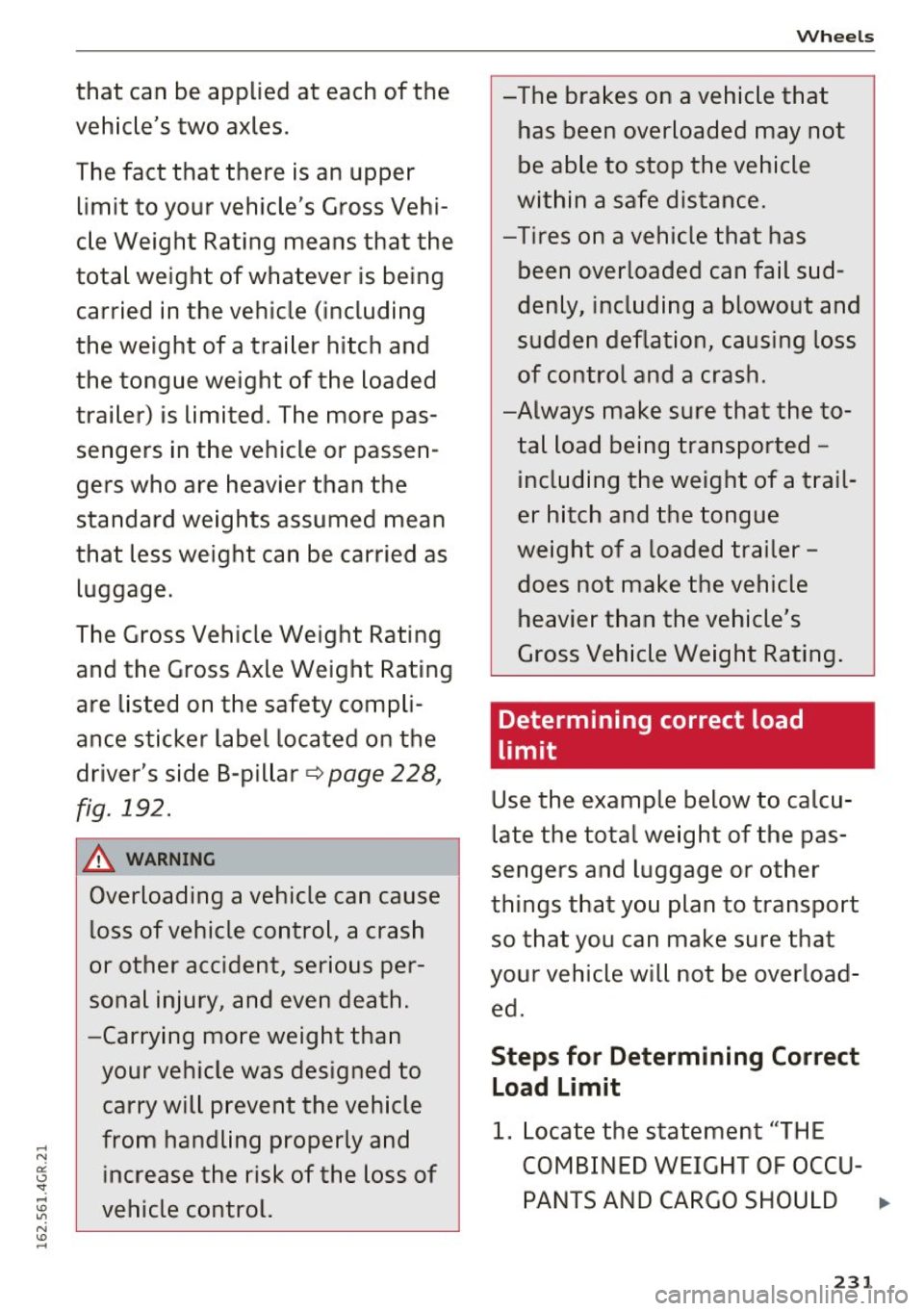
that can be applied at each of the
vehicle's two axles.
The fact that there is an upper
limit to your vehicle 's Gross Vehi
cle Weight Rating means that the
total weight of whatever is being carried in the vehicle (including
the weight of a trailer hitch and
the tongue weight of the loaded
trailer) is limited. The more pas sengers in the vehicle or passen
gers who are heavier than the
standard weights assumed mean
that less weight can be carried as luggage.
The Gross Vehicle Weight Rating and the Gross Axle Weight Rating
are listed on the safety compli
ance sticker label located on the
driver 's side 8-pillar
¢ page 228,
fig. 192.
& WARNING
-
Overloading a vehicle can cause
loss of vehicle control, a crash
or other accident, serious per
sonal injury, and even death.
-Carrying more weight than
your vehicle was designed to carry will prevent the vehicle
from handling properly and increase the risk of the loss of
vehicle control.
Wheels
-The brakes on a vehicle that
has been overloaded may not
be able to stop the vehicle
within a safe distance.
-Tires on a vehicle that has
been overloaded can fail sud
denly, including a blowout and
sudden deflation, causing loss
of control and a crash.
-Always make sure that the to
tal load being transported -
including the weight of a trail
er hitch and the tongue
weight of a loaded trailer - does not make the vehicle
heavier than the vehicle's
Gross Vehicle Weight Rating.
Determining correct load
limit
Use the example below to calcu
late the total weight of the pas
sengers and luggage or other
things that you plan to transport
so that you can make sure that
your vehicle will not be overload ed.
Steps for Determining Correct Load Limit
1. Locate the statement "THE
COMBINED WEIGHT OF OCCU-
PANTS AND CARGO SHOULD .,.
231
Page 234 of 282
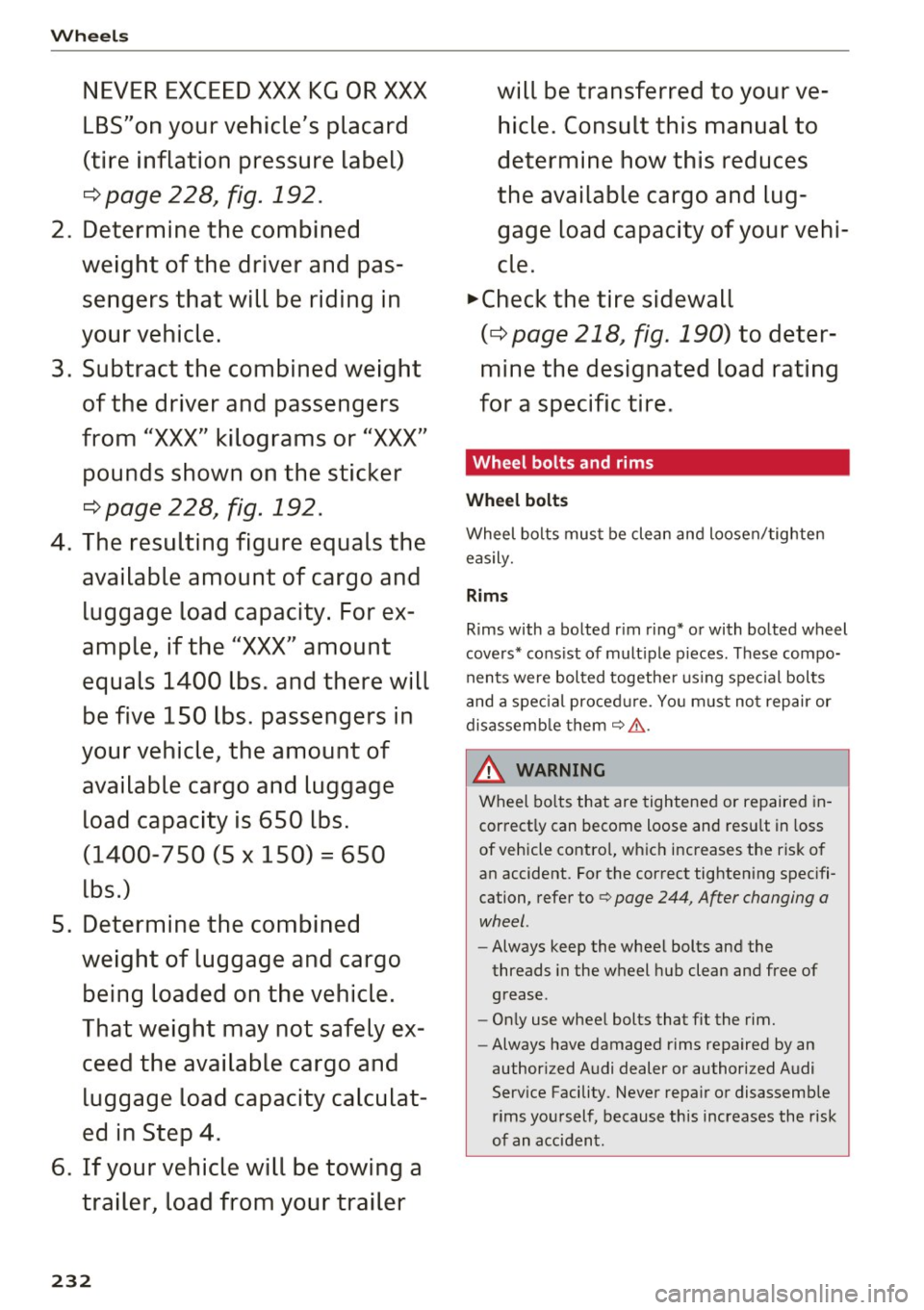
Wheels
NEVER EXCEED XXX KG OR XXX
LBS"on your vehicle's placard
(tire inflation pressure label)
¢page 228, fig. 192.
2. Determine the combined
weight of the driver and pas
sengers that will be riding in
your vehicle.
3. Subtract the combined weight
of the driver and passengers
from
"XXX" kilograms or "XXX"
pounds shown on the sticker
¢ page 228, fig. 192.
4. The resulting figure equals the
available amount of cargo and
luggage load capacity. For ex
ample, if the "XXX" amount
equals 1400 lbs. and there will
be five 150 lbs. passengers in
your vehicle, the amount of available cargo and luggage
load capacity is 650 lbs.
(1400-750 (5 X 150) = 650
lbs.)
5. Determine the combined
weight of luggage and cargo being loaded on the vehicle.
That weight may not safely ex ceed the available cargo and
luggage load capacity calculat
ed in Step 4.
6. If your vehicle will be towing a trailer, load from your trailer
232
will be transferred to your ve
hicle. Consult this manual to
determine how this reduces
the available cargo and lug
gage load capacity of your vehi
cle.
~check the tire sidewall
(¢page 218, fig. 190) to deter
mine the designated load rating
for a specific tire.
Wheel bolts and rims '
Wheel bolts
Wheel bolts must be clean and loosen/tighten
easily.
Rims
Rims with a bolted rim ring* or with bolted wheel
covers* consist of multiple pieces. These compo
nents were bolted together using special bolts
and a special procedure . You must not repair or
disassemble them
9 &. .
_&. WARNING
Wheel bolts that are tightened or repaired in
correctly can become loose and result in loss
of vehicle control, which increases the risk of
an accident. For the correct tightening specifi
cation, refer to
9 page 244, After changing a
wheel .
-Always keep the wheel bolts and the
threads in the wheel hub clean and free of
grease .
- Only use wheel bolts that fit the rim.
- Always have damaged rims repaired by an
authorized Audi dealer or authorized Audi
Service Facility. Never repair or disassemble
rims yourself, because this increases the risk
of an accident.
Page 235 of 282
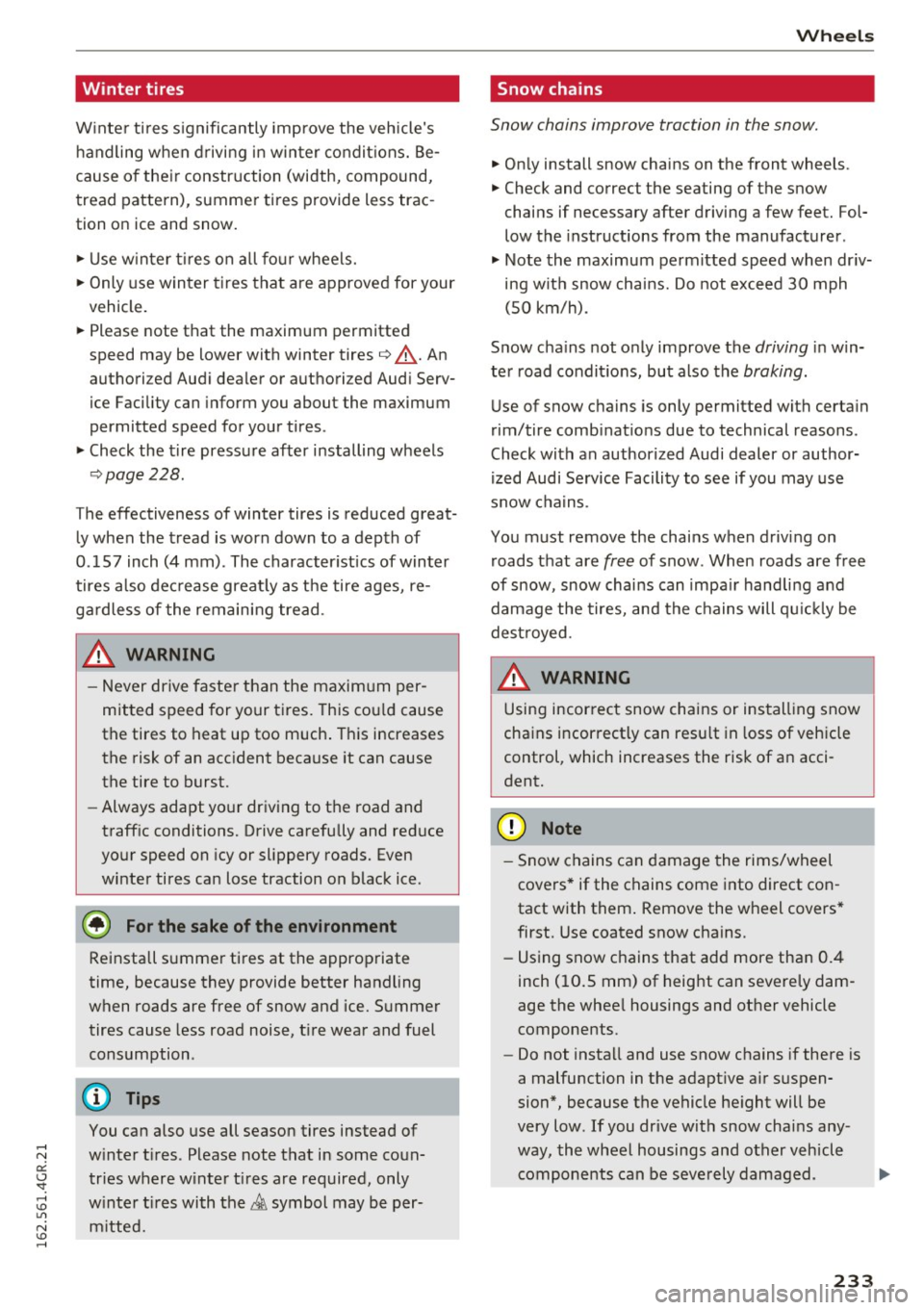
Winter tires
Winte r ti res s ignificantly improve the veh icle's
handling when driving in winter condit ions. Be
cause of the ir construction (width, compound,
tread pattern), summer tires provide less trac
tion o n ice and snow.
,.. Use w inter t ires on all fo ur wheels.
,.. Only use winter t ires that are approved for your
vehicle.
,.. Please note that the maximum permitted
speed may be lower with winter tires
9 &, . An
authorized Audi dealer or authorized Audi Serv
ice Facility can inform you about the maximum
permitted speed for your tires.
,.. Check the tire press ure after installing wheels
9page 228.
The effectiveness of winter tires is reduced great
ly when the tread is worn down to a depth of
0 .1 57 inch (4 mm). The character istics of winter
tires a lso dec rease great ly as the tire ages, re
ga rdless of the remaining tread.
_& WARNING
- Never drive faster than the maxim um per
mitted speed for your tires. This cou ld cause
the tires to heat up too much . Th is increases
the risk of an accident because it can cause
the tire to burst.
- Always adapt your dr iv ing to the road and
traff ic conditions. Drive carefully and reduce
your speed on icy or slippery roads. Even
winter tires can lose traction on black ice.
@ For the sake of the environment
Reinstall summer ti res at the appropriate
time, because they provide better handling
when roads are free of snow and ice. Summer tires cause less road noise, t ire wear and fuel
consumption.
You ca n also use all season tires instead of
w inter t ires. Please note that in some coun
tries where w inter t ires are required, only
w inter t ires with the
& symbol may be per
m itted.
-
Wh eel s
Snow chains
Snow chains improve traction in the snow .
,.. On ly install snow chains on the front wheels.
,.. Check and correct the seating of the snow
chains if necessary after driving a few feet. Fol
low the instruct ions from the manufacturer.
,.. Note the maximum permitted speed when dr iv
ing wit h snow chains. Do not exceed 30 mph
(SO km/h) .
Snow cha ins not o nly improve the
driving in win
te r road condit ions, but also the
braking.
Use of snow chains is only permitted with certa in
rim/tire comb inat ions due to technical reasons.
Check with an authorized Audi dealer or author
ized Audi Service Facili ty to see if you may use
snow c ha ins.
You must remove the chains when driving on roads that are
free of snow . When roads are free
of snow, snow chai ns can impa ir handling and
damage the tires, and the chains will qu ic kl y be
dest royed.
_& WARNING ~
Using incorrect snow chains or ins tall ing snow
chains incorrect ly can resu lt in loss of veh icle
control, which increases the risk of a n acci
dent.
(D Note
- Snow chains can damage the rims/wheel
covers* if the chains come into direct con
tact with them . Remove the wheel covers*
first. Use coated snow chains.
- Using snow c hains that add more than 0.4
inch ( 10.5 mm) of height can severely dam
age the whee l housings and other vehicle
components.
- Do not insta ll and use snow chains if there is
a malfunction in the adapt ive a ir suspen
sion*, because the vehicle he ight will be
very low. If you drive with snow chains any
way, the wheel housings and other vehicle
components can be seve rely damaged.
233
Page 236 of 282
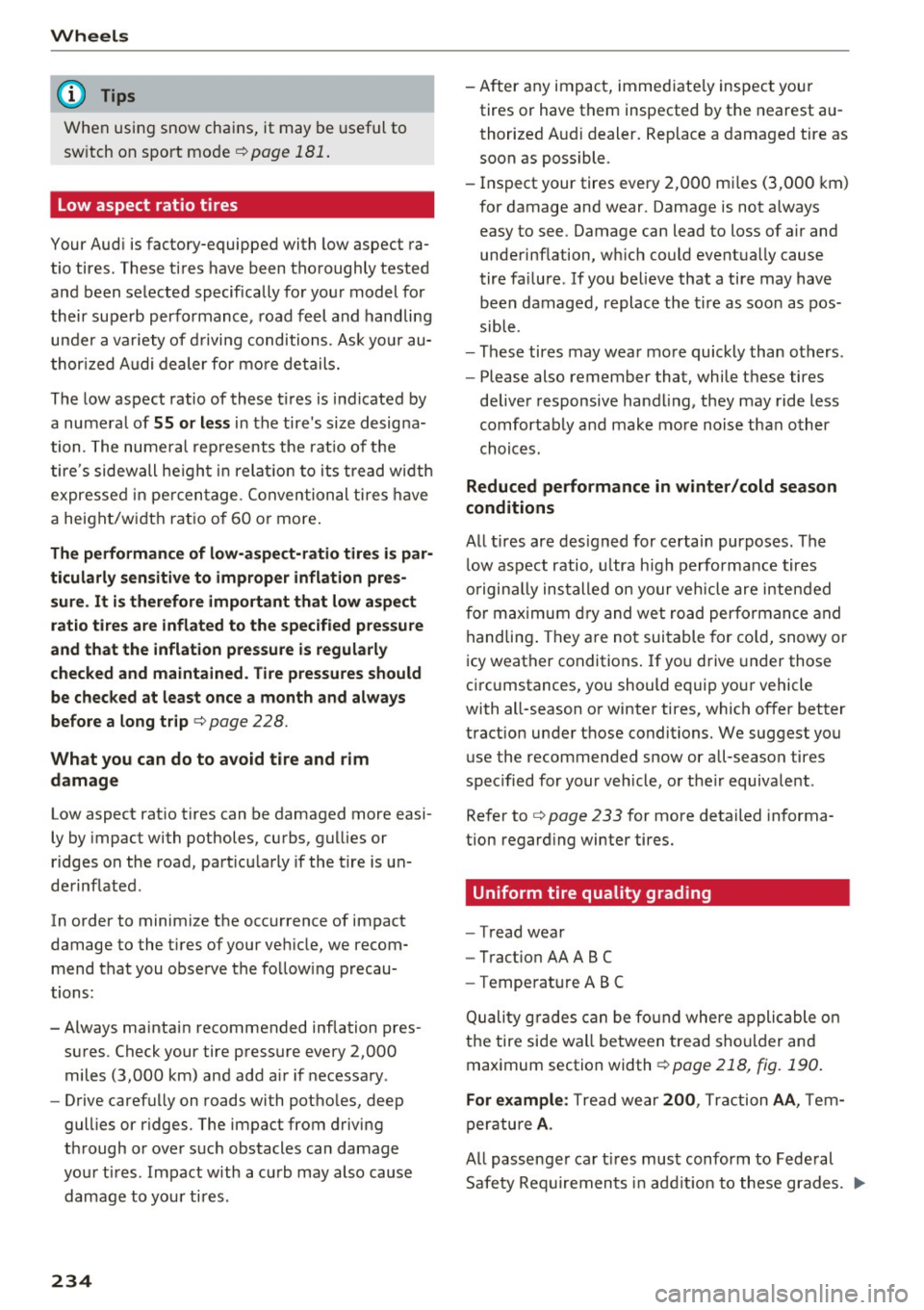
Wheels
(D Tips
When using snow chains, it may be useful to
sw itch on sport mode
¢ page 181.
Low aspect ratio tires
Your Aud i is factory-equipped with low aspect ra
tio tires. These tires have been thoroughly tested
and been selected specifically for your model fo r
thei r supe rb perfo rmance, road feel and handling
unde r a va riety of d riving conditions . As k yo ur au
thor ized Audi dealer for mo re de tails.
The low aspect ratio of these t ires is indicated by
a nume ra l of
55 or less in the tire's size desig na
tion . The nume ra l rep resents the rat io of t he
tire 's sidewall he igh t in relat io n t o it s tread w idth
e xpresse d in percen tage. Convention al ti res have
a height/w idth ratio o f 60 o r more .
The performance of low -aspect-ratio tires is par
ticularly sensitive to improper inflation pres
sure. It is therefore important that low a spect
ratio tires are inflated to the specified pre ssure
and that the inflation pressure is regularly
checked and maintained. Tire pressures should
be checked at le ast once a month and alwa ys
before a long trip¢
page 228.
What you can do to avoid tire and rim
damage
Low aspect rat io tires can be damaged more easi
ly by impact with potholes, curbs, gullies or
ridges on the road, pa rt icu la rly if the t ire is un
de rinflated.
In order to minimize the occurrence of impact
damage to the t ires of your ve hicle, we recom
mend that you observe the fo llow ing precau
tions:
- Always maintain recommended inflation pres
su res . Check your tire pressure every 2,000
miles (3,000 km) and add air if necessary .
- Drive caref ully on roads with potho les, deep
gul lies or r idges . The impact from drivi ng
through or over s uch obstacles can damage
you r tires. Im pact with a cu rb may also cause
damage to you r tires .
234
-After any impact, immed iate ly inspect you r
tires or have them inspected by the nearest au
thorized Aud i dealer. Replace a damaged tire as
soon as possible.
- Ins pect your tires every 2,000 mi les (3,000 km)
for damage and wear . Damage is not always
easy to see . Damage can lead to loss of a ir and
underinfla tion, w hich could even tua lly cause
tire fa ilure . If yo u be lieve that a tire may have
been damaged, replace the tire as soon as pos
sible.
- These tires may wear mo re quickly than others .
- Please also remember that, while t hese tires
delive r responsive hand ling, they may ride less
comforta bly and make mo re noise than o ther
choi ces.
Reduced performance in winter/cold season
conditions
A ll ti res are des igned for certain purposes. The
l ow aspect ratio, ultra h igh performance tires
o rigina lly ins talled on your veh icle are inten ded
f o r m ax imu m dr y and wet ro ad perfo rma nce and
handling . They a re not sui table for co ld, snowy or
i cy weather conditions . If yo u drive under those
c ir cu mstances, you should equip yo ur vehicle
with all-season o r winter tires, which offer better
tract ion under t hose conditions. We suggest you
use the recommended snow or a ll-season tires
spec ified for your vehicle, o r th e ir equiva le nt.
Re fer to
c:> page 233 for more detailed in forma
tion regard ing winter tires.
Uniform tire quality grading
- Tread wea r
- Tract io n AA AB C
- Tempe rature ABC
Quali ty g rades can be fo und whe re appli cab le on
t h e tire side wall between tread shou lder and
max imum section width
¢ page 218, fig. 190 .
For example : Tread wear 200 , Traction AA , Tem
per atu re
A .
All passenge r ca r tir es mus t conform to Fede ral
Safety Req uiremen ts in add it io n to these grades . ..,.
Page 237 of 282
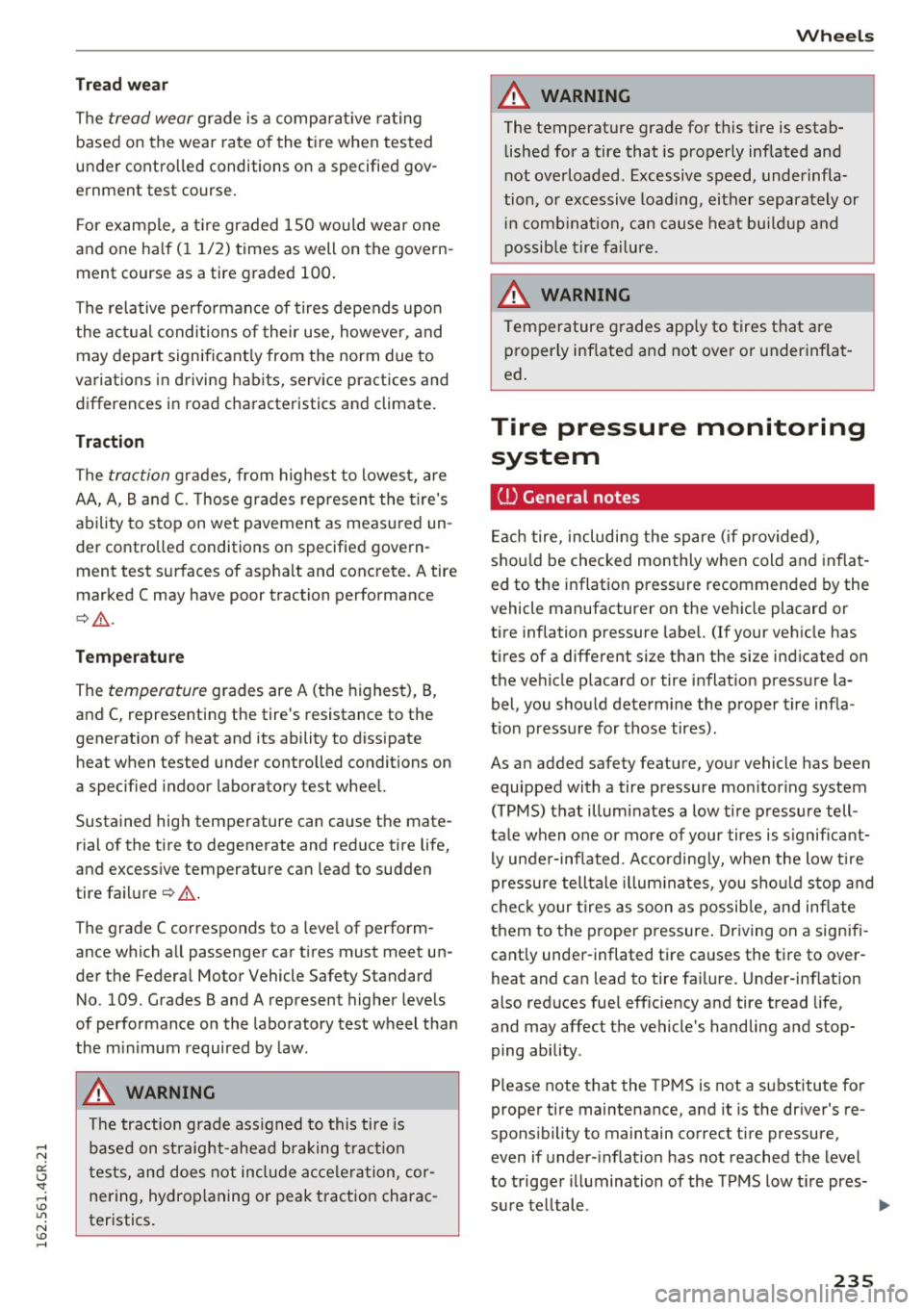
Tread wear
The
tread wear grade is a comparative rating
based on the wear rate of the tire when tested
under controlled conditions on a specified gov
ernment test course.
F or example, a t ire graded 150 would wear one
and one half (11/2) times as well on the govern
ment course as a tire graded 100 .
The relative performance of tires depends upon
the actual conditions of their use, however, and
may depart significantly from the norm due to
variations in driving habits, service practices and
differences in road characteristics and climate .
Traction
The
traction grades, from highest to lowest, are
AA, A, Band
C. Those grades represent the tire's
ability to stop on wet pavement as measured un
der controlled conditions on specified govern ment test surfaces of asphalt and concrete. A tire
marked C may have poor traction performance
¢ .&, .
Temperatur e
The
temperature grades are A (the highest), B,
and C, representing the tire's resistance to the
generation of heat and its ability to dissipate heat when tested under controlled conditions on
a specified indoor laboratory test wheel.
Sustained high temperature can cause the mate rial of the tire to degenerate and reduce tire life,
and excessive temperature can lead to sudden
tire failure
c:> .&, .
The grade C corresponds to a level of perform
ance which all passenger car tires must meet un
der the Federal Motor Vehicle Safety Standard No. 109. Grades Band A represent higher levels
of performance on the laboratory test wheel than
the minimum required by law.
A WARNING
-
The traction grade ass igned to this tire is
based on straight-ahead braking traction
tests, and does not include acceleration, cor
nering, hydroplaning or peak traction charac
teristics.
Wheels
A WARNING
The temperature grade for this tire is estab lished for a tire that is properly inflated and
not overloaded. Excessive speed, underinfla
tion, or excessive loading, either separately or
i n comb inat ion, can cause heat buildu p and
possible tire failure.
A WARNING
-
-
Temperature grades apply to tires that are
properly inflated and not over or underinflat
ed.
Tire pressure monitoring system
ill General notes
Each tire, including the spare (if provided),
shou ld be checked monthly when cold and inflat
ed to the inflation pressure recommended by the
vehicle manufacturer on the vehicle placard or
tire inflation pressure label. (If your vehicle has
tires of a different size than the size indicated on
the vehicle placard or tire inflation pressure la
bel, you should determine the proper tire infla
t ion pressure for those tires).
As an added safety feature, your vehicle has been equipped with a tire pressure monitor ing system
(TPMS) that illuminates a low tire pressure tell
tale when one or more of your tires is significant ly under -inf lated. Accordingly, when the low t ire
pressure telltale illuminates, you should stop and
check your tires as soon as possib le, and inflate
them to the proper pressure . Driving on a signifi
cant ly under-inflated tire causes the tire to over
heat and can lead to tire failure. Under-inflation
also reduces fue l efficiency and tire tread life,
and may affect the vehicle's handling and stop
ping ability .
Please note that the TPMS is not a substitute for
proper tire maintenance, and it is the driver's re
sponsibility to maintain correct tire pressure,
even if under-inflation has not reached the level
to trigger illumination of the TPMS low tire pres-
sure telltale . .,.
235
Page 238 of 282
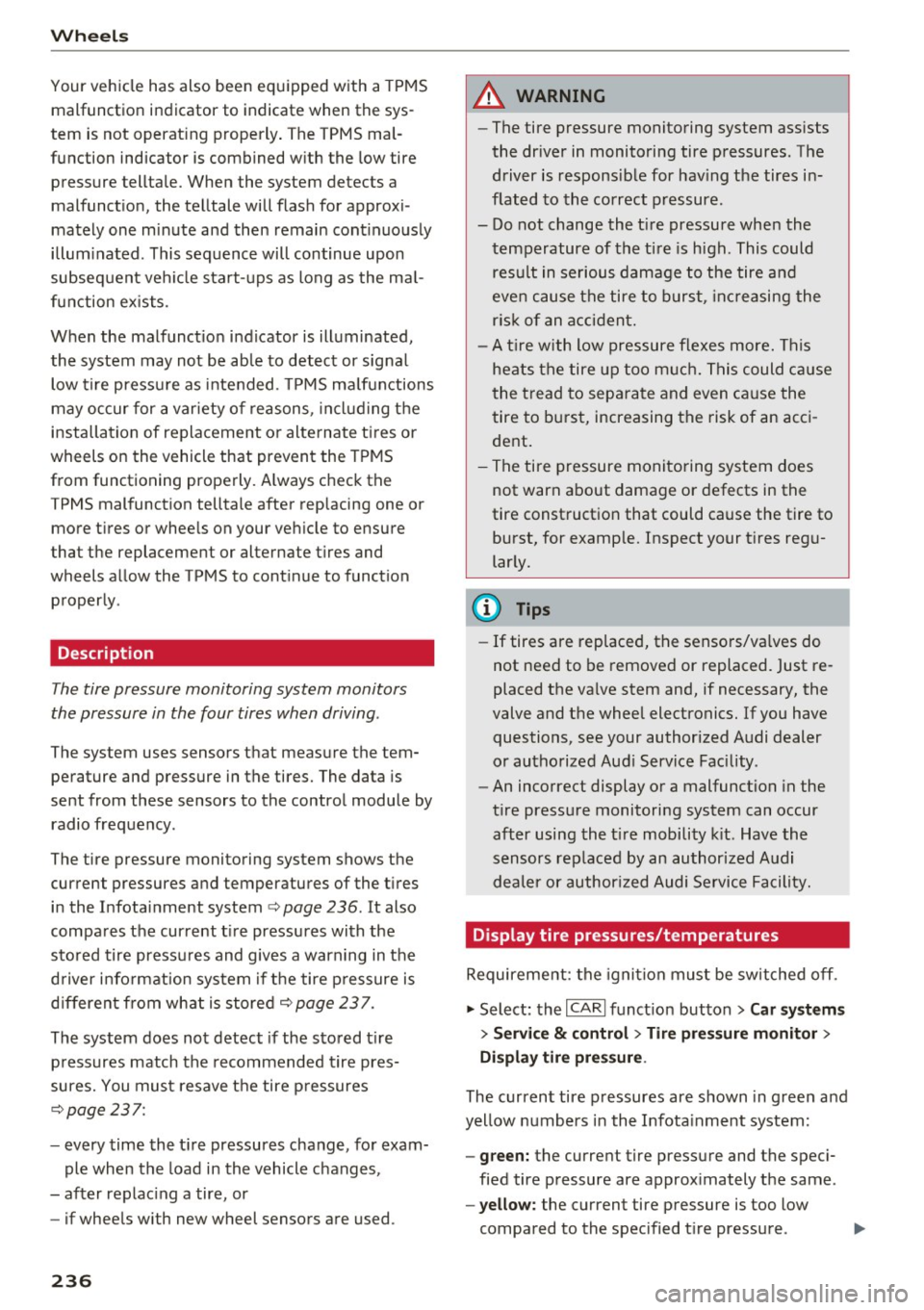
Wheels
Your vehicle has also been equipped with a TPMS
malfunction indicator to indicate when the sys
tem is not operat ing properly . The TPMS mal
function indicator is combined with the low tire pressure telltale. When the system detects a
malfunction, the telltale will flash for approxi
mately one minute and then remain cont inuously
illum inated . This sequence will continue upon
subsequent veh icle start-ups as long as the ma l
function ex ists .
When the malfunct io n indicator is illuminated,
the system may not be able to detect or signal low tire pressu re as intended . TP MS ma lfunctions
may occur for a variety of reasons, including the
installation of replacement or alternate ti res or
wheels on the vehicle that prevent the TPMS
from functioning properly. A lways check the
TPMS malfunction telltale after replacing one or
more tires or wheels on your vehicle to ensure
t hat the replacement or alternate tires and
wheels allow the TPMS to continue to function
properly.
Description
The tire pressure monitoring system monitors
the pressure in the four tires when driving .
The system uses sensors that measure the tem
perature and pressure in the tires. The data is
sent from these sensors to the control module by
radio frequency .
The tire pressure monitoring system shows the current pressures and temperatures of the tires in the Infotainment system
c.>page 236. It also
compares the current t ire pressures with the
stored tire pressures and gives a warning in the
driver information system if the tire pressure is
d ifferent from what is stored¢
page 237.
The system does not detect if the stored t i re
pressures match the recommended tire pres
sures. You must resave the tire pressures
c.> page 23 7:
-every time the tir e pressures change, for exam
ple when the load in the vehicle changes,
- after replac ing a tire, or
- if wheels with new wheel sensors are used .
236
A WARNING ,_
- The tire pressure monitoring system ass ists
the dr iver in monitoring tire pressures. The
driver is responsible for having the tires in
flated to the correct pressure.
- Do not change the t ire pressure when the
temperature of the tire is high . This could
result in serious damage to the tire and
even cause the tire to burst, increasing the
ris k of an accident.
- A tire with low pressure flexes more. This
heats the tire up too much. This could cause
the tread to separate and even cause the
tire to burst, increasing the risk of an acci
dent .
- The tire pressure monitoring system does
not warn about damage or defects in the
tire construction that could cause the tire to burst, for example. Inspect your t ires regu
larly.
@ Tips
- If tires are replaced, the sensors/va lves do
not need to be removed or replaced. Just re
placed the va lve stem and, if necessary, the
valve and the wheel electronics. If you have
questions, see your authorized Audi dealer
or authorized Audi Service Facility.
- An incorrect display or a malfunction in the
tire pressure monitoring system can occur
after using the tire mobility kit. Have the
sensors rep laced by an authorized Audi
dealer or authorized Audi Service Facility.
Display tire pressures/temperatures
Requirement: the ignition must be switched off.
.,. Select: the
I CARI funct ion button > Car systems
> Service & control > Tire pressure monitor >
Display tire pre ssure .
The current tire pressures are shown in green and
yellow numbers in the Infotainment system:
-green: the current tire pressure and the spec i
fied tire pressure are approx imately the same .
-yellow: the current tire pressure is too low
compared to the spec ified t ire pressure .
Page 239 of 282
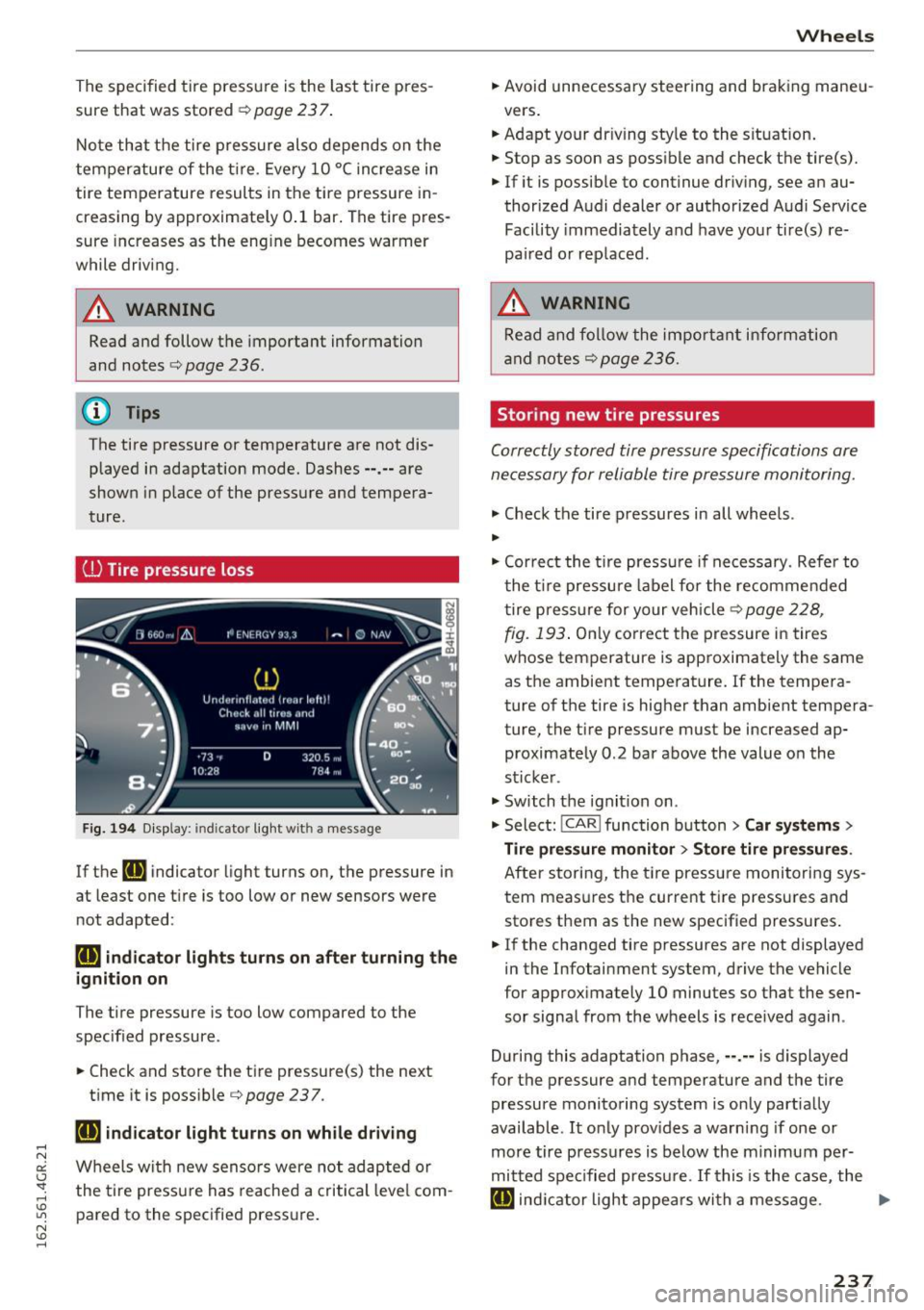
The specified tire pressure is the last tire pres
sure that was stored
¢ page 2 3 7 .
Note that the tire p ressure also depends on the
temperature of the t ire . Every 10 °C increase in
tire temperature results in the tire pressure in
creasing by approximate ly 0 .1 bar. The tire pres
sure increases as the eng ine becomes warmer
while driving.
A WARNING
Read and follow the important information
and notes <=>
page 236.
@ Tips
The tire pressure or temperature are not dis played in adaptation mode. Dashes ··.·· are
shown in place of the pressure and tempera
ture .
(D Tire pressure loss
Fig. 194 Display : indic ato r light with a message
If the [IJ indicator light turns on, the pressure in
at least one t ire is too low or new sensors were
not adapted :
rt] indicator lights turns on after turning the
ignition on
The tire pressure is too low compared to the
specified pressure.
"' Check and store the tire pressure{s) the next
time it is possible<=>
page 237.
rt] indicator light turns on while driving
Wheels with new senso rs were not adapted or
the tire pressure has reached a critical leve l com
pared to the specified pressure.
Wheels
"' Avoid unnecessary steering and braking maneu-
vers .
"' Adapt your dr iving sty le to the situation .
"' Stop as soon as possible and check the tire(s).
"' If it is possib le to continue driving, see an au-
thorized Audi dealer or authorized A udi Service
Facility immediately and have your tire(s) re
pa ired or rep laced.
A WARNING
Read and follow the important i nformation
and notes
¢page 236.
Storing new tire pressures
Correctly stored tire pressure specifications are
necessary for reliable tire pressure monitoring.
"' Check the tire pressures in all wheels .
..
"'Cor rect the tire pressure if necessa ry. Refer to
the tire pressure label for the re commended
t ire pressure for your vehicle
c> page 228,
-
fig. 193 . Only correct the pressure in tires
whose temperature is approximately the same
as the ambient temperature. If the tempera
ture of the tire is higher than ambient tempera
ture, the tire pressure must be increased ap
proximately 0 .2 bar above the value on the
sticker .
"' Switch the ignition on .
"' Select:
!CAR ! function button> Car systems>
Tire pressure monitor > Store tire pressures .
After storing, the tire pressure monitoring sys
tem measures the current tire pressures and
stores them as the new specified pressures .
"'If the changed tire pressures are not displayed
in the Infotainment system, drive the vehicle
for approximately 10 minutes so that the sen
sor signal from the wheels is received again .
During this adaptation phase, ··.·· is displayed
for the pressure and temperature and the tire
pressure monitoring system is only partially
available .
It only prov ides a warning if one or
more tire pressures is below the minimum per
mitted spec ified pressu re. If this is the case, the
[IJ indic ator light appea rs with a message . ""
237
Page 240 of 282
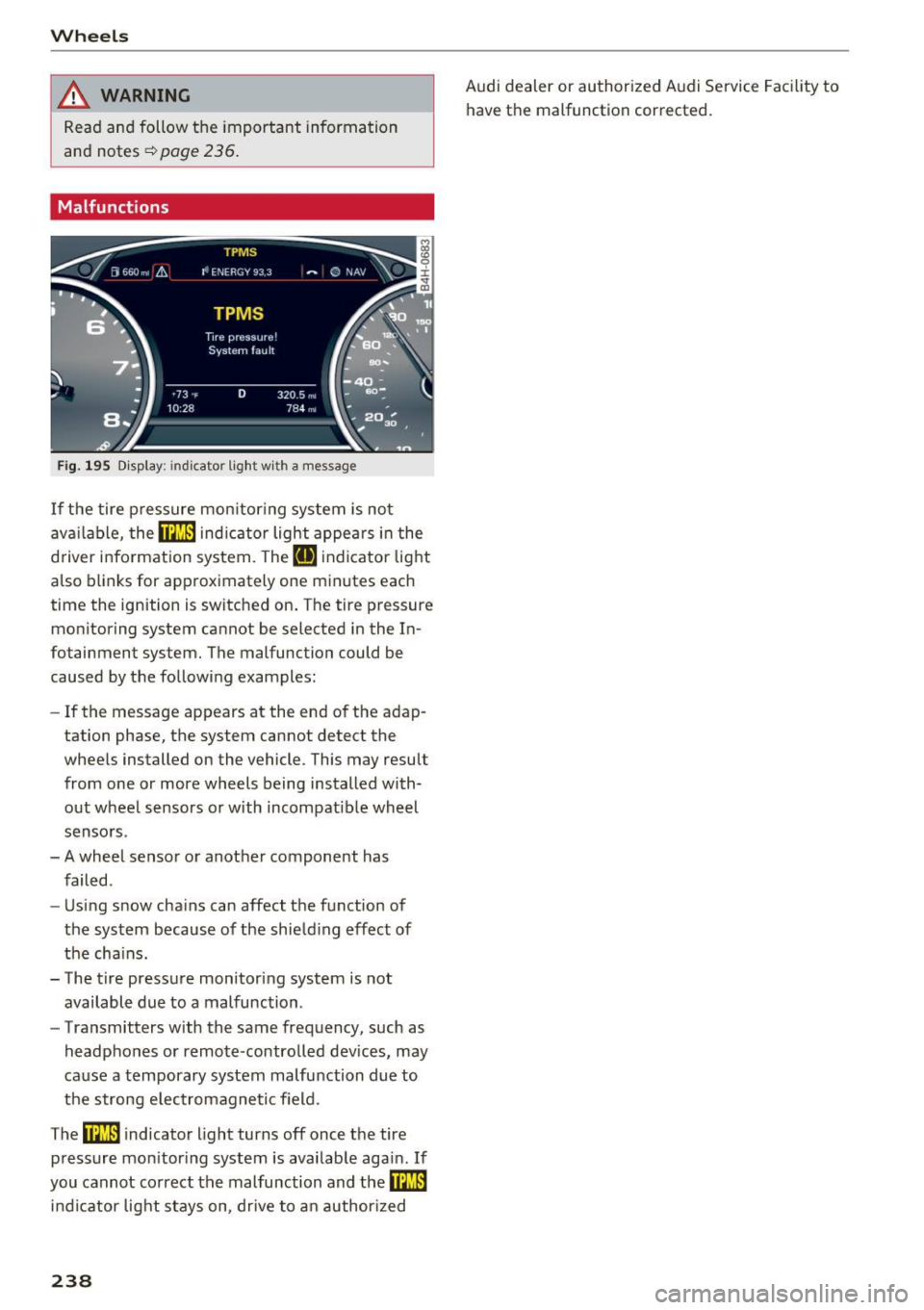
Wheels
_& WARNING
Read and follow the important information
and notes¢
page 236.
Malfunctions
Fig . 195 D isp lay: indicator lig ht w ith a message
If the tire p ressure mon itoring system is not
ava ilable,
the m indic a tor light appea rs i n the
d river information system. The
RI] ind icato r light
also blinks for approximately one minutes each
time the ignition is switched on . The tire pressure
monitoring system cannot be selected in the In
fotainment system. The malfunction could be
caused by the following examples:
- If the message appears at the end of the adap
tation phase, the system cannot detect the
whee ls installed on the vehicle. This may result
from one o r more wheels being installed with
out wheel sensors or with incompatible wheel
senso rs.
- A wheel senso r or anot her component has
failed .
- Using snow cha ins can affect the function of
the system because of the shie ld ing effect of
the cha ins.
- The t ire pressure monitoring system is not
available due to a malfunction .
- Transmitters with the same frequency, such as
headphones or remote-controlled devices, may
ca use a temporary system malfu nction due to
the strong e lec trom agne tic field.
The
ffim i ndicator light turns off once the tire
pressure mon itor ing system is available aga in . If
you cannot correct the malfunction and
the m
in dicator light stays on, drive to an author ized
238
Audi dealer or authorized Audi Service Facility to
have the malfunction corrected.